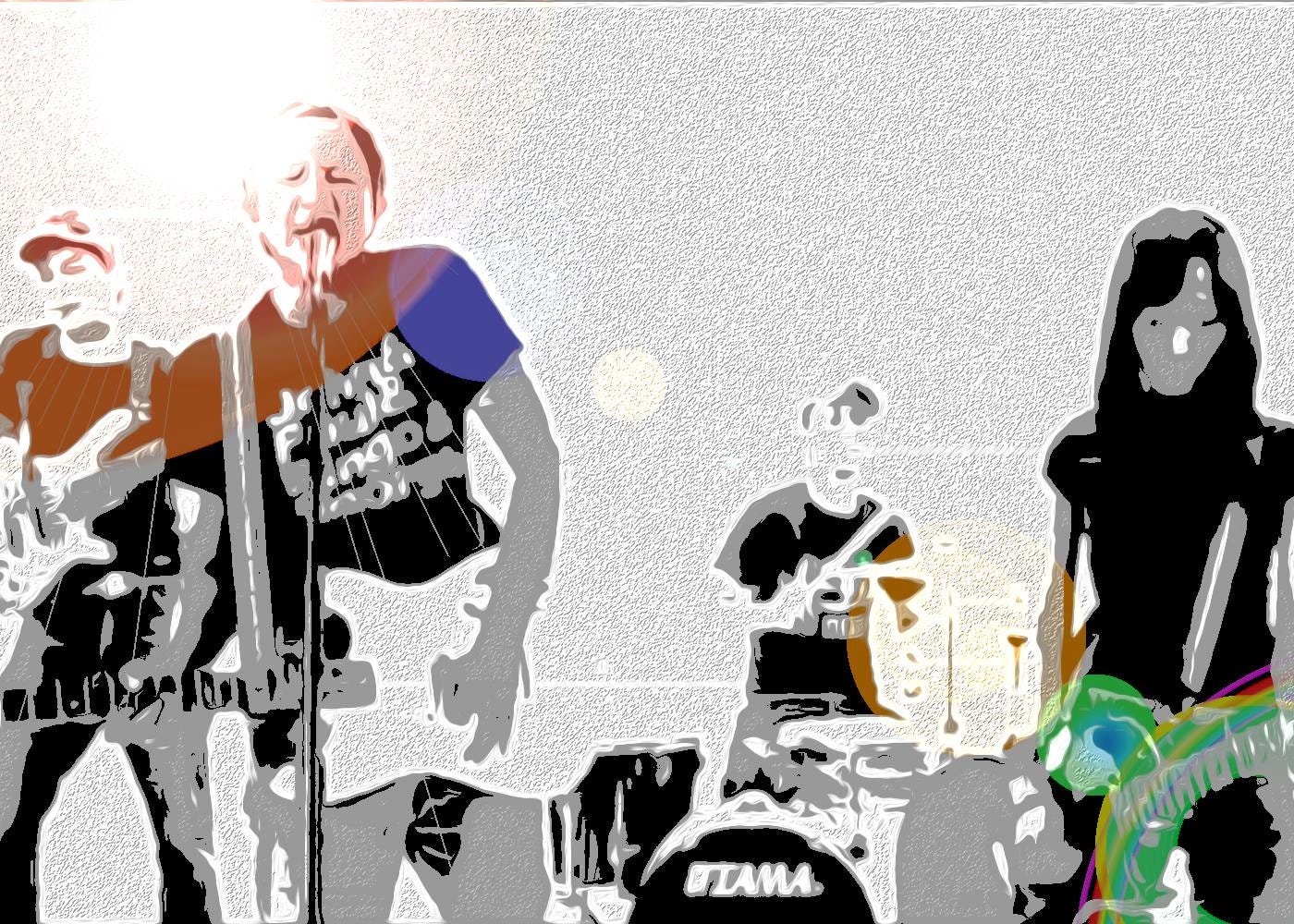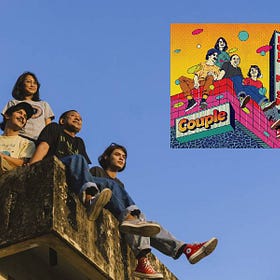We have published 4 volumes of our semi-annual Guitar Pop Journal. In addition to artist and album deep dives, we’ve featured a few comprehensive scene reports from around the rock and roll globe. This week, I’m thrilled to share an excellent excerpt from RTL:AGPJ, Volume 2, written by Aidil Rusli of Malaysian indie/power pop band Couple.—S.W. Lauden
A Brief History of Southeast Asian Guitar Pop
By Aidil Rusli
As a power pop fanatic, how I wish there was enough material for me to write exclusively about the power pop scene in Malaysia, or at the very least, in Southeast Asia, which includes countries like Malaysia, Indonesia, Singapore, Thailand, the Philippines and a few more.
It’s only after taking up the wider banner of ‘guitar pop’ that such a piece is possible. Even then, I’ll need to speed through the 1970s and 1980s—foundational years for the genre in the Western Hemisphere—because there really wasn’t much going on over here during that time.
Even if the 1960s were at least quite groovy over here, with the ‘pop-yeh-yeh’ fever standing in for Beatlemania throughout Southeast Asia with countless garage bands—some only known in their respective countries like Malaysia’s A Romzi & the Hooks, Indonesia’s Koes Bersaudara and Singapore’s Kassim Slamat & the Swallows, and some receiving belated recognition from the other side of the world like Malaysia’s Adnan Othman and Singapore’s Truck—we have no equivalent of a Big Star, Raspberries, the Knack, the Jam, or even the Smiths during the 1970s and 1980s around these parts.
The real history of Southeast Asian guitar pop definitely began in the 1990s, specifically somewhere during the first half of that decade.
That’s thanks to the increasing prevalence of satellite dishes (legal or otherwise) and MTV, which brought the whole ‘alternative nation’ and pre-Brit pop Creation Records phenomenon to these shores, resulting in the formation of some crucial bands such as the Oddfellows from Singapore (a wonderful band influenced by the Replacements), Brit pop-influenced acts like Eraserheads from the Philippines, and Pure Saturday from Indonesia, Thai alternative rock pioneers Moderndog, and Malaysia’s Old Automatic Garbage (more fondly known as OAG).
As a teenage metalhead slowly venturing out into other genres during these years—getting into the more melodic delights offered by bands such as Weezer, Manic Street Preachers, Sloan, the Posies and a whole bunch of Swedish pop bands like the Wannadies, This Perfect Day and Eggstone—to hear some of these sounds in the aforementioned regional acts was quite refreshing.
As a Malaysian, OAG was the band closest to my heart back during these formative years.
They arrived on the scene with their self-titled debut album in 1994, calling their music ‘60s crunchy pop fuzz’ and armed with a groundbreaking music video for their debut single “60s TV” that had them gatecrashing the Malaysian mainstream the way Nirvana had with “Smells Like Teen Spirit” a couple of years earlier.
Concurrently, in the Malaysian underground, there were also plenty of young bands doing their own versions of the guitar-pop thing, mostly from a town called Kuching in East Malaysia. The most beloved of these acts was Nice Stupid Playground, a Brit pop-influenced combo with a very strong Swedish pop melodic sensibility, who was also later signed to Positive Tone, the indie label that gave OAG their big break.
I formed my band Couple in 1995, initially just as a guitar pop band because I had no idea that the music I loved and would end up making was called power pop.
I loved Weezer, Teenage Fanclub, Matthew Sweet, the Posies and a whole bunch of melodically inclined punk/indie rock bands like Smoking Popes, the Muffs, the Riverdales, the Mr. T Experience, Superchunk and Sonic Surf City. I combined my love for those alternative acts with their Southeast Asian counterparts and started writing the kind of melodic noise I loved listening to. And that was it.
It's only toward the beginning of the 2000s, after I was out of my teenage years and after returning to Malaysia from studying in the UK for three years, that I began to really pay attention to the nooks and crannies of musical genres, especially of the guitar pop. It was in the UK that I first realized power pop was the music I liked and that it was different from indie pop—and that even within the indie pop genre there were dozens of sub-genres ripe for discovery.
Coming back from the UK and kickstarting my band again after a three-year break meant that I was bound to get into contact with fellow regional guitar pop enthusiasts, and there’s no way that anyone can talk about guitar pop in Indonesia without talking about Mocca—the country’s biggest indie/twee pop export—and their Bandung-based indie label FFWD Records (which, in addition to having a roster of influential rock and roll bands like the S.I.G.I.T. and Teenage Death Star, also handles Indonesian releases for international indie pop acts like the Cherry Orchard, Club 8, Jens Lekman and Edson).
With their albums distributed and by touring across Malaysia, Singapore, Thailand, South Korea and Japan, Mocca was a pretty big name in Southeast Asia back in the early-to-mid 2000s.
They won plenty of MTV and industry awards in Asia with their debut album, My Diary, which reportedly sold more than 100,000 copies despite being on an indie label. Having shared stages with Mocca quite a few times during this period, I can definitely say that they lived up to the media hype with their excellent swing-/jazz-influenced indie pop tunes that often incited huge singalongs at their shows.
This period also saw the emergence of another highly respected (but sadly now defunct) indie label in Indonesia, Aksara Records, which was based in Jakarta. It was home to a host of now very influential bands such as Sore, the Adams, White Shoes & the Couples Company, and Efek Rumah Kaca, all of whom are still active to this day and now almost exclusively playing big festivals and arena/ballroom shows.
For me, though, the single most important guitar pop band to emerge in Indonesia from this era was definitely Naif, even if they’re from the major label arena.
Debuting with a self-titled album in 1998, they released a total of seven albums—with a few “Best Of,” live and B-sides compilations released in between—with their final album 7 Bidadari released in 2017.
Influenced by plenty of ‘60s and ‘70s guitar pop, Naif came close to power pop perfection quite a few times in their storied career, and even though they’ve never been as big as the mainstream staples of this era like Sheila On 7, Dewa 19, or Padi, they were beloved enough to be feted with a tribute album released by Aksara Records in 2007 (including a Nerves-inspired cover of one of their songs by my band Couple).
The mid-2000s was a golden era for guitar bands in the region, thanks to a Malaysian television series called KAMI that debuted in 2007.
The show was about a group of teenage kids who happened to like going to gigs. I don’t think anyone ever anticipated how much of a cultural phenomenon that series would turn out to be—dragging indie bands and the whole punk rock/gig culture into the Malaysian mainstream and leading throngs of kids to whatever gigs they could find in their hometowns.
By some stroke of luck, Couple had about eight songs featured in the series, so we were dragged along for the ride, but being a power pop band I knew that we would never be one of the breakout acts. That honor was reserved for Meet Uncle Hussain (who did the series’ theme song) and Hujan, who took the scene by storm in 2008 thanks to their captivating debut EP 1, 2, 3 Go! and its follow up Check Check Rock Rock. Hujan would go on to become one of the biggest rock bands in Malaysia, and remain one of the country’s top draws today.
Lost among this mainstream scramble for Malaysian indie guitar pop was Ferns, one of the country’s finest indie/twee pop bands. Ferns’ debut album On Botany was released in 2007 and is an internationally respected guitar pop classic that’s ripe for rediscovery.
The same is true for Furniture, a former post rock/shoegaze band that embraced guitar pop with their glorious second album from 2011, They Made Me Out of Dreams You’ve Forgotten.
Talking about indie pop, Thailand has a pretty happening scene that started in the mid-2000s.
I first got acquainted with the Thai scene after Couple performed at Fat Festival in Bangkok in 2006. At the center of that scene is Smallroom Records, an indie label that has more or less released all the essential guitar pop albums out of that country since 1999, including great bands like Lemon Soup, Penguin Villa, Slur, and the Richman Toy.
And of course, let’s not forget about our blood brothers/sisters from Singapore, which was actually once part of Malaysia before becoming its own country in 1965. That’s where I met two self-proclaimed power pop bands: Popland (which had its second album Action released by Zip Records in the US) and TypeWriter (which even managed to feature Ken Stringfellow of the Posies on vocals for one of the songs from their debut album).
A couple other equally great Singapore bands include the now defunct Serenaide (indie/twee pop) and the Pinholes (terrifically hooky garage pop/rock), who are still actively gigging and making new music.
Nowadays there’s even a very strong new batch of guitar pop bands flying the Singapore flag, led by two bands that are signed to Topshelf Records: Sobs and Subsonic Eye.
And indie/twee pop is still alive and well in the Philippines, too, with irresistible bands like the Buildings and the Purest Blue. And if you want to explore a wonderful legacy band, the Camerawalls’ blindingly great Bread and Circuses EP from 2010 is a perfect place to start.
In short, there are plenty of guitar pop bands just waiting to be discovered here in Southeast Asia, even if most remain hidden to the outside world. Let’s hope that changes soon.
Aidil Rusli is a power pop geek from Malaysia. He formed his band Couple in 1995, which is still going strong to this very day, with their latest album Poptimism released in late 2022. He thinks you should check them out, NOW!
Interview: Aidil Rusli
The beautiful thing about great music is that it’s always there, waiting to be discovered. I was reminded of this recently when I got lured down a rabbit hole by Couple, Malaysia’s favorite—and perhaps only—self-described power pop band.






